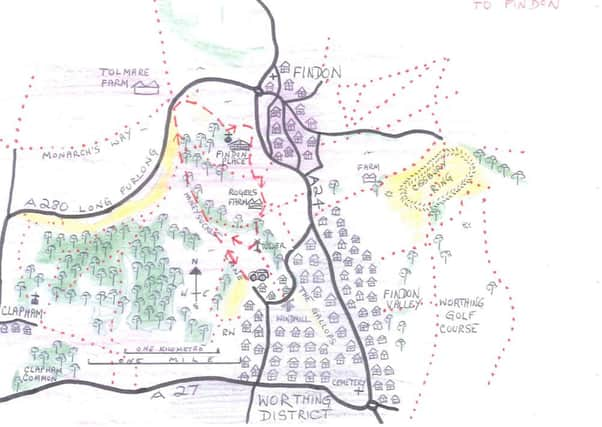RICHARD WILLIAMSON: Country walk: Honeysuckle Lane to Findon


Beyond that are the wide-open downland fields where 3,000 years ago our ancestors had their own farms. I much enjoyed this 3.3-mile (5.5kms) walk across these bracing hills with their views of the sea far below.
Free parking is at the start of Honeysuckle Lane, one kilometre north of the A27.
Advertisement
Hide AdAdvertisement
Hide AdA lot of people drive here just to admire the view southwest to the Channel and to exercise their dogs on the flower-rich open-space meadow that falls away below. A grand crop of hardheads (Centaurea nigra) which attract butterflies in late summer have grown there.
I walked the mile-and-a-half northward up the hilltop track called Honeysuckle Lane, though I failed to see any of the fragrant bines myself.
There was plenty of blackthorn, blackberry, oak, sycamore, ash and wild rose however.
Soon the trees fade away and you feel on top of the world with the sea on your left and the old Iron Age fort of Cissbury Ring on your right.
Advertisement
Hide AdAdvertisement
Hide AdEventually the far distant hill at Henley can be seen ahead left. Nearer by are the two round hills of Blackpatch and then Harrow Hill beyond that.
Both were sacred places to the Ancient Brits as well as being flint mines.
As you go downhill, please do note the wonderful array of wild Viburnam – wayfaring trees among the dogwood, buckthorn, privet and spindle.
Devil’sbit scabious is among the flowers growing on the wild downland slopes left and below.
Advertisement
Hide AdAdvertisement
Hide AdYou can see some of the Bronze Age field boundaries on the fields below as well. Just before the main road, climb the bank to left and find the footpath going east through the root field.
This is Monarch’s Way and it takes you southeast downhill through sycamore woods and meadows to St John Baptist. Note the female and male yew trees either side of the kissing gate.
The church was the subject of some eccentric remodelling of its north aisle 600 years ago. Again, it was revamped in 1867.
Note the flint chimney outside. Down the lane pass 300-year-old Findon Place, looking classically serene inside its smooth-clipped yew hedge.
Advertisement
Hide AdAdvertisement
Hide AdBefore reaching the A24, turn right on yellow arrow through kissing gate, passing the park with its walnut trees and onwards to South Lodge.
Turn left, then right, along concrete track to Roger’s Farm. Left through farmyard gate, then soon right up steep hill into the woods.
Continue up hill over the crossways, passing a grove of beech trees with lovers’ carvings on the bark and so back on to the top of the hill, passing the radio mast to the left.
Two ways back to your car, left or right as per my map. I chose to go right and so back on to my outgoing path in order to enjoy that fabulous top-of the-world feeling again.